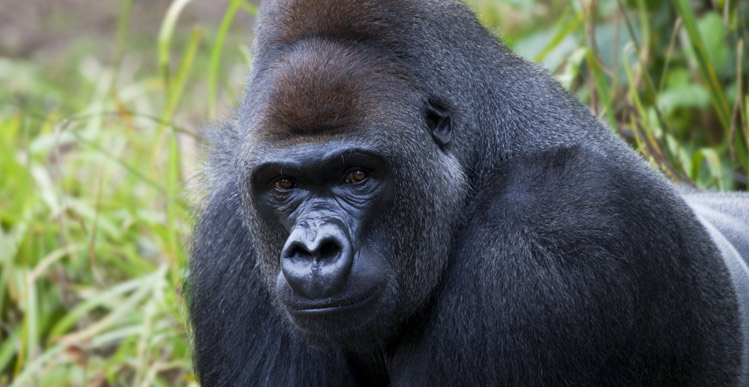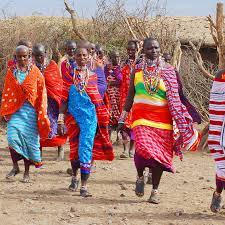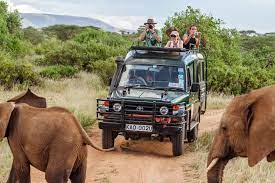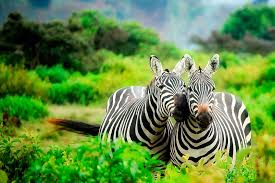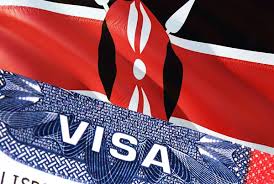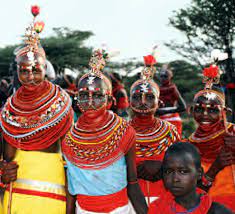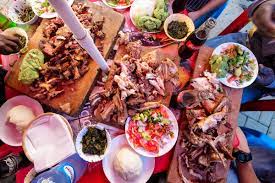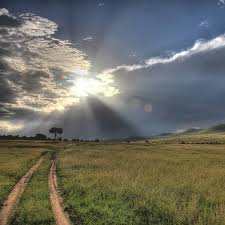Overview
Mgahinga Gorilla National Park sits high in the clouds, at an altitude of between 2,227m and 4,127m. As its name suggests, it was created to protect the rare mountain gorillas that inhabit its dense forests, and it is also an important habitat for the endangered golden monkey. As well as being important for wildlife, the park also has a huge cultural significance, in particular for the indigenous Batwa pygmies. This tribe of hunter-gatherers was the forest’s “first people”, and their ancient knowledge of its secrets remains unrivalled. Mgahinga’s most striking features are its three conical, extinct volcanoes, part of the spectacular Virunga Range that lies along the border region of Uganda, Congo and Rwanda. Mgahinga forms part of the much larger Virunga Conservation Area which includes adjacent parks in these countries. The volcanoes’ slopes contain various ecosystems and are biologically diverse, and their peaks provide a striking backdrop to this gorgeous scenery.
Best Time to Visit
Mgahinga Gorilla NP is open for gorilla trekking the whole year, but the best time is during the drier seasons from June to August and December to January. At this time the trails tend to be easier to navigate and spending a precious hour with the gorillas might be more pleasant when it isn’t raining.
Best Time June to August and December to January (trekking gorilla is easier because the trails are drier)
High Season June to September (Gorilla tracking permits are hard to get at short notice)
Low Season March, April, May, October and November (Some lodges and camps shut down)
Best Weather June to August and December to January (Less rainfall)
Worst Weather March to May and September to November (Higher rainfall, forest trails might be challenging)
June to August and December to January –Dry Seasons
Drier trails make gorilla trekking easier
Time spent with gorillas is more pleasant when it doesn’t rain
Days are sunny
Views are clouded by the hazy air
February to May and September to November –Wet Seasons
Gorilla can still be tracked at this time of the year
Migratory birds are present
When the clouds lift, the views are amazing
Wet trails are hard to hike, and road conditions can become bad
It might drizzle for days, and it tends to be misty and wet
Hailstorms are common
Getting There
Mgahinga Gorilla NP is 510km/317mi from Kampala. If visited as part of a Ugandan tour, Mgahinga can be reached by road from Queen Elizabeth NP (three to four hours), or from Lake Mburo NP (five to seven hours). If coming straight from Entebbe or Kampala, the trip will take about eight hours. A 4WD vehicle is essential in the Wet seasons (from February to May and September to November). Mgahinga can also be reached by flight. Your point of entry into Uganda is Entebbe International Airport (EBB), located about 46km/29mi from the capital, Kampala. It is possible to take a domestic flight from Entebbe to Kisoro, 14km from the main entrance gate of Mgahinga.
Activities
There are lots of things to see in Mgahinga Gorilla National Park. From the endangered mountain gorillas to golden monkeys, three of the Virunga Volcanoes and unique flora and fauna. Here are the top attractions of Mgahinga National Park. that you should not miss! Checkout the full list of things to see in the park
Mountain Gorillas
Mgahinga Gorilla National Park is home to more than half of the world’s population of the endangered mountain gorilla. Fortunately for the gorillas are the main reason as to why the park was created by the Uganda government.
Virunga Volcanoes
Mgahinga is one of the most scenic given that the park lies on the northern slopes of Mt. Muhabura, Mgahinga and Sabyinyo. These three volcanoes create an unforgettable regional backdrop.
Golden Monkeys
Mgahinga Gorilla National Park is the only destination where Silver meets Gold. The park protects both mountain gorillas and golden monkeys. The golden monkeys are an ancient group of monkeys that are only found in the Virunga.
Mount Sabyinyo
Sabinyo has three peaks. Sabyinyo is a local word that comes from the word ‘Iryinyo’, meaning tooth. The borders of three countries converge on this summit and you will find yourself simultaneously in Rwanda, Congo and Uganda.
Mount Gahinga
Mgahinga National Park derives its name from this volcanic mountain.This dormant/extinct volcano lies on the border between Uganda and Rwanda. An ascent of Mount Gahinga climbs from Ntebeko takes around 6 hours.
Mount Muhavura
This classic volcanic cone is capped by a small but lake; a modest reward for a 5 hour trek that rises 1700m to over 41OOm. The word Gahinga comes from the local Rufumbira dialect meaning “a small pile of stones”.
Things to Do in Mgahinga National Park
There are lots of things to do in Mgahinga Gorilla National Park. From gorilla trekking to Volcano Hiking, Mgahinga is such a place where you can engage in several adventure activities. Check out the full list of things to do in Mgahinga.
Gorilla Tracking
Gorilla Tracking is the most popular activity that is done in Mgahinga Gorilla National Park. Most travelers to Mgahinga visit the park for mountain gorilla trekking. There is one habituated gorilla family i.e Nyakagezi Gorilla Family.
Volcano Hiking
Though gorilla tracking is the park’s most popular activity, Mgahinga merits a visit simply to appreciate the scenery. A choice of hikes allows for all abilities, ranging from the 8 hour return trip to the summit of Mt. Muhabura, to gentle strolls across the lower slopes beneath the magnificent three peak backdrop.
Golden Monkey Tracking
Golden monkey tracking is one of the top activities that make this park an interesting place for tourists to visit for a primate safari. Challenge yourself an engage in this life changing activity and achieve an excitement of a lifetime.
Batwa Trail
The Batwa Trail leads from the base of Muhavura Cave. This walk is conducted by Batwa guides who provide insights into their traditional forest life and culture. The Batwa used to live with the gorillas in hamony within the Mgahinga Forests.
Bird Watching
Mgahinga Gorilla National Park is ideal for birding. Bird through different places including the Buffalo Wall, forests, wetlands and other habitats. Some of the birds to see include ibis, speckled mous, fire finch and many others found in the area.
Garama Cave Exploration
The 342m long Garama Cave lies beneath a plateu northern edge of the park, 3km from Ntebeko. It is set in the former farmland zone but in earlier times, the cave forest when it was occupied periodically by Batwa who used it as a council chamber and a retreat.
Uniqueness
The fact that Mgahinga National Park is a home to mankind’s close relatives-the mountain gorillas, it is undeniable that gorilla trekking in the main reason as to why tourists visit this National park. This Park is a home to only 80 mountain gorillas and only one mobile habituated gorilla group named the Nyakagezi group, which means only 8 gorilla permits for 8 persons are sold per day for this Gorilla group. Gorilla trekking within this Park starts with pre-tracking briefing at 7:00am from Ntebeko Visitor Center and only one hour is permitted for tourists to spend with these remarkable creatures. The prime reason for visiting Mgahinga Gorilla National Park is to see mountain gorillas and visitors should first book a gorilla safari with one of the local tour operators. The best way to see gorillas is to go gorilla trekking with Uganda Wildlife Authority guides. Trekking commences early morning from Ntebeko, the main visitor center. The park has only one habituated gorilla family called Nyakagezi with baby gorillas and a 50 year old Silverback gorilla which often moves long distances. Many trekkers hire a porter to assist in carrying bags or give you a push along steep climbs since you can’t tell when you’ll locate gorillas and return back from the forest.
Though seeing gorillas in the park is guaranteed, visitors should be aware of the steep terrain that requires fitness and unpredictable rainfall makes it necessary to carry enough drinking water, packed lunch and rain jackets. Mgahinga Gorilla National Park is preferred for gorilla trekking because it’s easy to encounter them due to the availability of much vegetation which is food for gorillas and may move less as well as the forest cover which is bamboo covered. Uganda Wildlife Authority (UWA) habituated one group of mountain gorillas called Nyakagezi Group which has 9 members including the 50 year old Silverback called Bugingo as well as two playful baby gorillas. Experienced guides and trackers have knowledge about habituated gorilla manners. The park is close to Bwindi Forests where 400 gorillas live that make up half of the world’s mountain gorilla population, (only 880 mountain gorillas left on earth). This makes it easy for tourists to combine both Mgahinga National Park and Bwindi Impenetrable National Park for a wider gorilla tracking experience and a diverse collection of other activities. It’s in this park where you are guaranteed to encounter mountain gorillas because Nyakagezi group stabilized within Uganda and has for more than three years not moved to the Democratic Republic of Congo (DRC) or Rwanda instead we have it that other gorillas move from DRC and Rwanda and cross over to Mgahinga Gorilla National Park.
What is the Best Time to See Mountain Gorillas?
The best time for gorilla trekking is the dry season from June to October and December to February because hiking trails are less muddy and slippery, but the activity can also be conducted in the wet season which is also the low season where gorilla permits are discounted.
What is the Cost for Gorilla Permits?
Gorilla permits during normal seasons and the Peak season is $600 per person for foreign non residents, $500 for foreign residents and Shs 250,000 for East African Community residents. The discounted permits for the low season (April, May and November) cost $450 for foreign non residents, $400 for foreign residents and Shs 150,000 for East African Community residents.
Gorilla Trekking – Dos & Don’ts
Gorilla Trekking is one of the top wildlife adventures you can overtake in Africa. However, since the advent of gorilla tourism, strict rules have been put in place to ensure that mountain gorillas are protected well. That is why within all the destinations where tourists go for gorilla trekking, there are various precautions that one should put into consideration. These rules and regulations are strictly followed so that both tourists and mountain gorillas are protected as well ensuring smooth running of the gorilla trekking activity. So the following should be put into consideration;
- Protect the gorillas – if you are sick or have any infectious diseases, don’t go. If you don’t feel well you need to sit this one out to safeguard the well-being of these endangered animals.
- Remember your manners – if you cough or sneeze turn away and cover your nose and mouth to reduce the chances of transmitting bacteria or viruses to the primates.
- Don’t overstay your welcome – expect to spend only the allotted one hour with the gorillas, departing when the time is up.
- Keep your distance – stay at least 5-7 meters (21 feet) away from the gorillas, not because they are dangerous but because they are wild and we can transmit diseases to them.
- Behave yourself – keep the noise levels down (from within 200m), don’t point and don’t use your flash when taking photographs.
- Go prepared – take warm and waterproof gear for the cool mountain conditions in these often wet forests and wear comfortable walking shoes.
- No snacking and smoking – you are not allowed to eat and drink or smoke around the gorillas.
- Clean up – wash your hands before going gorilla trekking.
- Keep your hands to yourself – You may not touch the gorillas even if they come close to you as these curious apes sometimes do.
- Hang onto your trash – don’t litter.
- Remain calm – if a gorilla charges, do not run away. Crouch down slowly and avoid direct eye contact, until the gorilla moves off.
- Toilet etiquette – if you need to go then ask your guide to dig a hole in the forest and make sure it gets covered up afterwards.
- So having put the above precautions into consideration, you should now strive to get the best out of your gorilla trekking activity. Here are some of the tips to register the best memorable experience.
- Keep yourself covered – long pants, gaiters and socks help keep the bugs (red ants) at bay and gloves will protect you from stinging nettles and thorny branches.
- Get reasonably fit – the trek is usually a physically challenging and tiring mission through rough terrain, so you want to be relatively fit.
- Be equipped – carry enough water, waterproof bags for your camera and insect repellent as well sunscreen and a hat.
- Stay warm and dry – take warm and rainproof clothing with you to cope with the cold conditions up in the mountains.
- Join an organized gorilla trip – book through a tour company to simplify your travels and get the gorilla permits arranged for you beforehand.
- Choose your timing – try to avoid trekking in the rainy season (March to April and October to November) when the going gets tougher.
So I bet that when you happen to put the above into consideration, you will have your life time experience.

